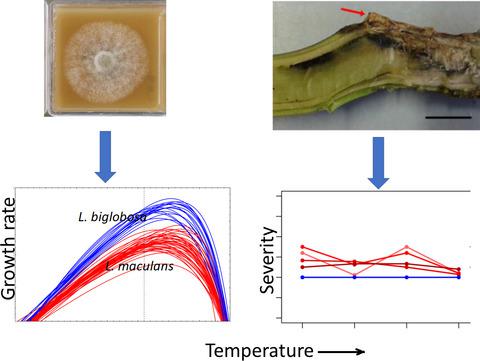当前位置:
X-MOL 学术
›
Plant Pathol.
›
论文详情
Our official English website, www.x-mol.net, welcomes your
feedback! (Note: you will need to create a separate account there.)
Inter‐individual genetic variation in the temperature response of Leptosphaeria species pathogenic on oilseed rape
Plant Pathology ( IF 2.3 ) Pub Date : 2020-07-20 , DOI: 10.1111/ppa.13236 Fay Newbery 1, 2 , Faye Ritchie 3 , Peter Gladders 3 , Bruce D. L. Fitt 2 , Michael W. Shaw 1
Plant Pathology ( IF 2.3 ) Pub Date : 2020-07-20 , DOI: 10.1111/ppa.13236 Fay Newbery 1, 2 , Faye Ritchie 3 , Peter Gladders 3 , Bruce D. L. Fitt 2 , Michael W. Shaw 1
Affiliation

|
It is important to understand the likely response of plant pathogens to increased temperatures due to anthropogenic climate change. This includes evolutionary change due to selection on genetically based variation in growth rate with temperature. We attempted to quantify this in two ways. First, radial mycelial growth rates in agar culture were determined for a collection of 44 English isolates of Leptosphaeria maculans and 17 isolates of L. biglobosa, at 14 temperatures. For L. maculans the genetic variances in four parameters were measured: minimum temperature allowing growth, optimum temperature, growth rate at the optimum temperature and growth rate at the highest usable temperature, 31.8°C. The standard deviations were 0.068 °C , 1.28°C, 0.21 mm day-1 and 0.31 mm day 1 °C-1 respectively. For L. biglobosa, these figures were, respectively: immeasurably small, 1.31 °C, 0.053 mm day-1 and 0.53 mm day- °C-1. In addition, the incidence and severity of phoma stem canker in planta over a natural growing cycle at four temperatures (16°C, 20°C, 24°C and 28°C) around the average culture optimum were determined. There was no correlation between in vitro and in planta growth, and the decrease in pathogen measures either side of the optimum temperature was much less for in planta growth than for in vitro growth. We conclude that both pathogens have the capacity to evolve to adapt to changes in environmental conditions, but that predictions of the effect of this adaptation, or estimates of heritability in natural conditions, cannot be made from measurements in vitro.
中文翻译:

油菜病原钩端螺旋体菌温度响应的个体间遗传变异
了解植物病原体对人为气候变化引起的温度升高的可能反应非常重要。这包括由于基于遗传的生长速率随温度变化的选择而导致的进化变化。我们试图通过两种方式对此进行量化。首先,在 14 个温度下,确定了 44 个英国分离株 Leptosphaeria maculans 和 17 个 L. biglobosa 分离株在琼脂培养中的径向菌丝体生长率。对于 L. maculans,测量了四个参数的遗传变异:允许生长的最低温度、最适温度、最适温度下的生长速率和最高可用温度 31.8°C 下的生长速率。标准偏差分别为 0.068 °C、1.28°C、0.21 mm day-1 和 0.31 mm day 1 °C-1。对于 L. biglobosa,这些数字分别为:小得无法估量,1.31 °C,0.053 mm day-1 和 0.53 mm day- °C-1。此外,还确定了在平均培养最佳值附近的四个温度(16°C、20°C、24°C 和 28°C)的自然生长周期内植物茎溃疡病的发生率和严重程度。体外和植物生长之间没有相关性,对于植物生长而言,最适温度两侧病原体测量值的降低远小于体外生长。我们得出结论,这两种病原体都有能力进化以适应环境条件的变化,但不能通过体外测量来预测这种适应的影响或自然条件下的遗传力估计。确定了在四个温度(16°C、20°C、24°C 和 28°C)围绕平均培养最佳值的自然生长周期内植物茎溃疡病的发生率和严重程度。体外和植物生长之间没有相关性,对于植物生长而言,最适温度两侧病原体测量值的降低远小于体外生长。我们得出结论,这两种病原体都有能力进化以适应环境条件的变化,但不能通过体外测量来预测这种适应的影响或自然条件下的遗传力估计。确定了在四个温度(16°C、20°C、24°C 和 28°C)围绕平均培养最佳值的自然生长周期内植物茎溃疡病的发生率和严重程度。体外和植物生长之间没有相关性,对于植物生长而言,最适温度两侧病原体测量值的降低远小于体外生长。我们得出结论,这两种病原体都有能力进化以适应环境条件的变化,但不能通过体外测量来预测这种适应的影响或自然条件下的遗传力估计。并且对于植物生长而言,在最适温度两侧的病原体测量值的减少远小于体外生长。我们得出结论,这两种病原体都有能力进化以适应环境条件的变化,但不能通过体外测量来预测这种适应的影响或自然条件下的遗传力估计。并且对于植物生长而言,在最适温度两侧的病原体测量值的减少远小于体外生长。我们得出结论,这两种病原体都有能力进化以适应环境条件的变化,但不能通过体外测量来预测这种适应的影响或自然条件下的遗传力估计。
更新日期:2020-07-20
中文翻译:

油菜病原钩端螺旋体菌温度响应的个体间遗传变异
了解植物病原体对人为气候变化引起的温度升高的可能反应非常重要。这包括由于基于遗传的生长速率随温度变化的选择而导致的进化变化。我们试图通过两种方式对此进行量化。首先,在 14 个温度下,确定了 44 个英国分离株 Leptosphaeria maculans 和 17 个 L. biglobosa 分离株在琼脂培养中的径向菌丝体生长率。对于 L. maculans,测量了四个参数的遗传变异:允许生长的最低温度、最适温度、最适温度下的生长速率和最高可用温度 31.8°C 下的生长速率。标准偏差分别为 0.068 °C、1.28°C、0.21 mm day-1 和 0.31 mm day 1 °C-1。对于 L. biglobosa,这些数字分别为:小得无法估量,1.31 °C,0.053 mm day-1 和 0.53 mm day- °C-1。此外,还确定了在平均培养最佳值附近的四个温度(16°C、20°C、24°C 和 28°C)的自然生长周期内植物茎溃疡病的发生率和严重程度。体外和植物生长之间没有相关性,对于植物生长而言,最适温度两侧病原体测量值的降低远小于体外生长。我们得出结论,这两种病原体都有能力进化以适应环境条件的变化,但不能通过体外测量来预测这种适应的影响或自然条件下的遗传力估计。确定了在四个温度(16°C、20°C、24°C 和 28°C)围绕平均培养最佳值的自然生长周期内植物茎溃疡病的发生率和严重程度。体外和植物生长之间没有相关性,对于植物生长而言,最适温度两侧病原体测量值的降低远小于体外生长。我们得出结论,这两种病原体都有能力进化以适应环境条件的变化,但不能通过体外测量来预测这种适应的影响或自然条件下的遗传力估计。确定了在四个温度(16°C、20°C、24°C 和 28°C)围绕平均培养最佳值的自然生长周期内植物茎溃疡病的发生率和严重程度。体外和植物生长之间没有相关性,对于植物生长而言,最适温度两侧病原体测量值的降低远小于体外生长。我们得出结论,这两种病原体都有能力进化以适应环境条件的变化,但不能通过体外测量来预测这种适应的影响或自然条件下的遗传力估计。并且对于植物生长而言,在最适温度两侧的病原体测量值的减少远小于体外生长。我们得出结论,这两种病原体都有能力进化以适应环境条件的变化,但不能通过体外测量来预测这种适应的影响或自然条件下的遗传力估计。并且对于植物生长而言,在最适温度两侧的病原体测量值的减少远小于体外生长。我们得出结论,这两种病原体都有能力进化以适应环境条件的变化,但不能通过体外测量来预测这种适应的影响或自然条件下的遗传力估计。











































 京公网安备 11010802027423号
京公网安备 11010802027423号